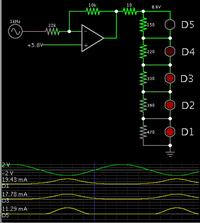Follow along with the video below to see how to install our site as a web app on your home screen.
Note: This feature may not be available in some browsers.

The schematic is wrong. If you connect the coil to GND to pin 3 of a 555, you will kill it.
If you want to transmit a signal at 190 kHz over a short distance, learn how to make a transistor oscillator. You can use a pair of AM radios for this purpose. One can be used as a transmitter (oscillator only), with a ferrite rod antenna tuned to 190 kHz. The other as a receiver- you will have to tune the receiver to 190 kHz. Or you can use another ferrite rod antenna with a simple detector (as a crystal set) as the receiver.
An easier way is to use a LED or IR LED with chopped light, and a photodiode with an amplifier tuned to chopping frequency. A distance over 10 meters can be covered.
any replacement for ferrite rod ???
what is chopped light in practice ? any schematic of photodiode amplifier with a tuner ? how could i build ?
yeah i got it
Actual problem is availability of ferrite rod arrangments due to FM radios in present time thats why i am asking about the option . .
Well without this ferrite rod how much approx distance , the transmission is possible ?
Suppose i apply a simple small coil of 18-24 guage wire parallel to 27 pf on both side,then what could be the range ?
please help me in designing a simple transistor oscilator
Ferrite rod antennas are used in AM radios, not FM. At long waves (for 190kHz, the wave length is about 1600 m) you need a large antenna to radiate a reasonable power. With a ferrite rod antenna you can radiate more power than with a long wire.
I can guide you in small steps, but what you need is to read a textbook on basic electronics. Best of all, find the ARRL radio amateurs' Handbook where you can find almost all you need, from designing a transistor oscillator to making a radio or light sensor as you started asking for.
When electronic hobbyists say that common inexpensive electronic parts are not available (they live on the moon?) then I tell them to do gardening instead of electronics.
My simple FM transmitter has a range of further than 2km to a sensitive hi-fi or car radio or across the street to a cheap FM radio from The Dollar Store.
The remote lock/unlock remote for my car has a range of about 150m.
My TV remote has a range of about 15m.